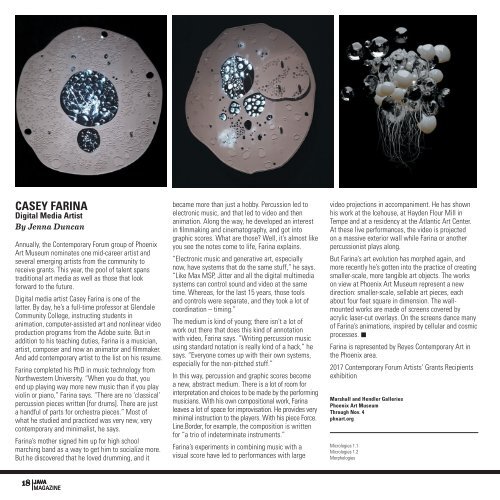You also want an ePaper? Increase the reach of your titles
YUMPU automatically turns print PDFs into web optimized ePapers that Google loves.
CASEY FARINA<br />
Digital Media Artist<br />
By Jenna Duncan<br />
Annually, the Contemporary Forum group of Phoenix<br />
Art Museum nominates one mid-career artist and<br />
several emerging artists from the community to<br />
receive grants. This year, the pool of talent spans<br />
traditional art media as well as those that look<br />
forward to the future.<br />
Digital media artist Casey Farina is one of the<br />
latter. By day, he’s a full-time professor at Glendale<br />
Community College, instructing students in<br />
animation, computer-assisted art and nonlinear video<br />
production programs from the Adobe suite. But in<br />
addition to his teaching duties, Farina is a musician,<br />
artist, composer and now an animator and filmmaker.<br />
And add contemporary artist to the list on his resume.<br />
Farina completed his PhD in music technology from<br />
Northwestern University. “When you do that, you<br />
end up playing way more new music than if you play<br />
violin or piano,” Farina says. “There are no ‘classical’<br />
percussion pieces written [for drums]. There are just<br />
a handful of parts for orchestra pieces.” Most of<br />
what he studied and practiced was very new, very<br />
contemporary and minimalist, he says.<br />
Farina’s mother signed him up for high school<br />
marching band as a way to get him to socialize more.<br />
But he discovered that he loved drumming, and it<br />
became more than just a hobby. Percussion led to<br />
electronic music, and that led to video and then<br />
animation. Along the way, he developed an interest<br />
in filmmaking and cinematography, and got into<br />
graphic scores. What are those? Well, it’s almost like<br />
you see the notes come to life, Farina explains.<br />
“Electronic music and generative art, especially<br />
now, have systems that do the same stuff,” he says.<br />
“Like Max MSP, Jitter and all the digital multimedia<br />
systems can control sound and video at the same<br />
time. Whereas, for the last 15 years, those tools<br />
and controls were separate, and they took a lot of<br />
coordination – timing.”<br />
The medium is kind of young; there isn’t a lot of<br />
work out there that does this kind of annotation<br />
with video, Farina says. “Writing percussion music<br />
using standard notation is really kind of a hack,” he<br />
says. “Everyone comes up with their own systems,<br />
especially for the non-pitched stuff.”<br />
In this way, percussion and graphic scores become<br />
a new, abstract medium. There is a lot of room for<br />
interpretation and choices to be made by the performing<br />
musicians. With his own compositional work, Farina<br />
leaves a lot of space for improvisation. He provides very<br />
minimal instruction to the players. With his piece Force.<br />
Line.Border, for example, the composition is written<br />
for “a trio of indeterminate instruments.”<br />
Farina’s experiments in combining music with a<br />
visual score have led to performances with large<br />
video projections in accompaniment. He has shown<br />
his work at the Icehouse, at Hayden Flour Mill in<br />
Tempe and at a residency at the Atlantic Art Center.<br />
At these live performances, the video is projected<br />
on a massive exterior wall while Farina or another<br />
percussionist plays along.<br />
But Farina’s art evolution has morphed again, and<br />
more recently he’s gotten into the practice of creating<br />
smaller-scale, more tangible art objects. The works<br />
on view at Phoenix Art Museum represent a new<br />
direction: smaller-scale, sellable art pieces, each<br />
about four feet square in dimension. The wallmounted<br />
works are made of screens covered by<br />
acrylic laser-cut overlays. On the screens dance many<br />
of Farina’s animations, inspired by cellular and cosmic<br />
processes.<br />
Farina is represented by Reyes Contemporary Art in<br />
the Phoenix area.<br />
2017 Contemporary Forum Artists’ Grants Recipients<br />
exhibition<br />
Marshall and Hendler Galleries<br />
Phoenix Art Museum<br />
Through Nov. 4<br />
phxart.org<br />
Micrologies 1.1<br />
Micrologies 1.2<br />
Morphologies<br />
18 <strong>JAVA</strong><br />
MAGAZINE


















